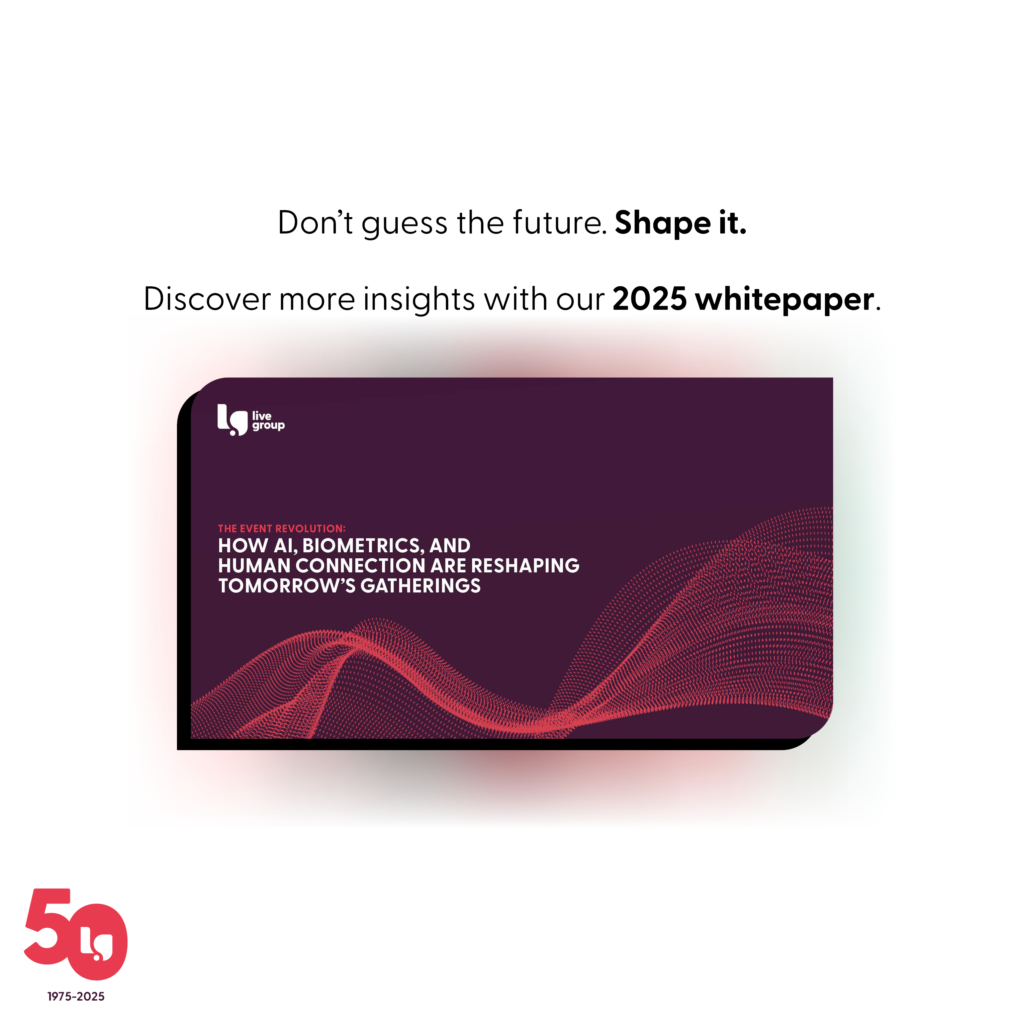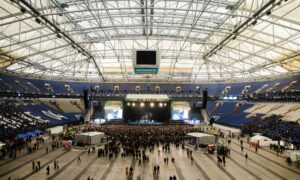Once considered an optional format, hybrid events have quickly become a core expectation across industries. But what are hybrid events, and why have they become so essential? Accelerated by the pandemic and fuelled by changing audience behaviours and travel challenges, hybrid events now offer a flexible, inclusive solution that meets the needs of modern attendees – both in-person and online.
Hybrid events have become the new standard for conferences, meetings, and corporate gatherings. With 91% of organisers planning hybrid events going forward, mastering this format is essential for event professionals. The key challenge? Creating an equally engaging experience for both in-person and virtual attendees.
What Are Hybrid Events and Why Do They Matter?
Hybrid events blend face-to-face networking with online access, dramatically expanding your reach. Take Salesforce’s Dreamforce conference, which attracted over 100 million virtual viewers by live-streaming in-person keynotes to a global audience. This expanded reach translates to greater impact, more leads, and enhanced brand visibility.
What Is the Advantage of Hybrid Events?
- Wider Reach – Engage a global audience without travel limitations.
- Greater Flexibility – Attendees choose how they want to participate.
- Cost Efficiency – Lower travel and venue costs for virtual attendees.
- Data & Insights – Track attendee behaviour and engagement in real-time.
- Inclusivity – Accommodates people with accessibility or health limitations.
How to Create a Seamless Hybrid Event Experience
The most successful hybrid events aren’t two parallel experiences—they’re one cohesive programme serving both audiences simultaneously. Here’s how to create this unified approach:

1. Start with Clear Objectives
Define what success looks like for your event. Set specific metrics for both attendance and engagement actions (questions asked, polls answered, networking connections made). Know your audience segments and tailor content accordingly—enterprises may require strict data controls, whilst agencies might prioritise detailed analytics.
2. Design for Digital-First
Always think ‘online first’ when planning. Every main session should be live-streamed with high production values. Encourage virtual attendees to submit questions and participate in polls during presentations, making them active contributors rather than passive viewers. Conversely, give on-site delegates ways to interact digitally through event apps.
3. Choose the Right Technology
Your platform should scale to your audience size, offer end-to-end encryption, and comply with relevant data protection laws. Invest in professional AV equipment—multiple camera angles, clear microphones for speakers and audience, and reliable internet with backup connections. Even minor streaming glitches will quickly lose remote engagement.
An all-in-one solution typically works best, integrating registration, badge printing, agendas, and analytics. Provide an event app or web portal where all attendees can view schedules, session links, venue maps, and participate in live polling.
4. Create Engaging Content for Both Audiences
Train speakers to address both camera and room, encouraging eye contact with the virtual audience and specific invitations for online questions. Keep sessions concise—virtual attention spans are shorter, so aim for 20-30 minute segments with varied formats.
Offer unique virtual content to ensure remote attendees don’t feel like second-class participants. This might include online-only Q&As with speakers, behind-the-scenes tours, or exclusive interviews. Always record sessions for on-demand access, helping those in incompatible time zones and extending engagement days after the event concludes.
5. Foster Real-Time Interaction
Embed polls, quizzes, and word clouds in sessions to gather instant feedback. Have moderators alternate between in-room and online questions. For breakout discussions, create parallel virtual sessions so remote attendees can also build connections in smaller groups.
Consider gamification strategies—award points for participation, display real-time leaderboards, or run contests with hashtags. Maintain a persistent chat or forum where discussions can continue throughout the event.
6. Hybrid Event Networking: Connecting In-Person and Virtual Attendees
Implement tools like 1:1 video meeting requests, AI matchmaking, and virtual ‘lounges’ to help attendees connect regardless of location. Create social media channels and display live feeds to highlight online interactions. When possible, arrange shared experiences where both audiences participate simultaneously.
7. Measuring the Success of Your Hybrid Events
Monitor engagement metrics in real-time to identify which sessions resonate most and where attention wanes. Send post-event surveys to gather feedback on both experiences. Follow up with highly engaged participants—those who joined multiple sessions, asked questions, or connected with sponsors.
Success Stories: Hybrid Events That Delivered
Several organisations have mastered the hybrid approach:
- HubSpot INBOUND used an integrated event app with dedicated meet-ups and lively forums for both audiences.
- Salesforce Dreamforce partnered with video producers to deliver broadcast-quality streaming to millions worldwide.
- VivaTech Paris offered digital participation options that multiplied attendance and revenue.
- Singapore’s Tourism Board created a ‘Resilience Roadmap’ for hybrid events, with local venues implementing advanced broadcast studios serving thousands of virtual attendees alongside in-person participants.
The Bottom Line
Successful hybrid events require intentional planning that considers both audience experiences from the start. By implementing clear goals, unified planning, secure technology, dynamic content, and interactive formats, you’ll create engaging experiences for everyone—regardless of where they participate from.
Remember, a hybrid event must make commercial sense and be deeply engaging for all participants. With the right strategy and attention to production quality, your hybrid events will maximise reach and deliver exceptional value to every stakeholder.
Hybrid events are conferences, meetings, or gatherings that combine in-person and virtual elements. They allow attendees to choose how they participate—either on-site or online – while ensuring everyone has access to the same content and engagement opportunities.
The main advantages of hybrid events include: Wider audience reach, Greater flexibility for attendees, Enhanced data collection and analytics, Increased accessibility and inclusivity, Cost savings for organisers and participants
Keep virtual attendees engaged by: Offering live interaction (polls, Q&As), Creating digital-only content or behind-the-scenes exclusives, Using professional-quality video and audio, Training speakers to engage both in-person and online audiences, Facilitating virtual networking through matchmaking tools or lounges
Hybrid events may require additional investment in technology, production, and platform fees. However, they can be more cost-effective in the long term due to increased reach, better ROI from data insights, and reduced travel or accommodation needs.
At minimum, you’ll need: A secure, scalable virtual event platform, High-quality audio/visual equipment, Live streaming capabilities, A mobile app or web portal for agenda access, interaction, and networking, Data analytics tools to measure engagement
Absolutely. Whether it’s a board meeting, a workshop, or a product launch, small-scale hybrid events can be just as effective. The key is to focus on creating value for both audiences, regardless of size.
Download our latest report to explore the latest event solutions, learn how event production agencies are leveraging technology for seamless conference planning, and uncover strategies to enhance hybrid event management.






